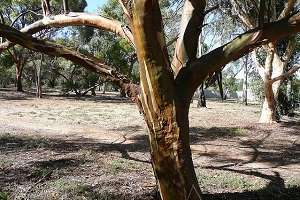Fire fuel found to diminish in ageing Great Western Woodlands

Research looking at vegetation structure changes in gimlet (Eucalyptus salubris) woodlands has provided insights into how time affects fuel availability for fire and habitat for biodiversity.
A study by Drs Carl Gosper, Colin Yates and Suzanne Prober from the Department of Parks and Wildlife and CSIRO Ecosystem Sciences measured the effects of "time-since-fire" on the 16 million ha Great Western Woodlands (GWW).
The GWW is the largest remaining area of intact Mediterranean-climate woodland on Earth, stretching from the edge of the Wheatbelt to Kalgoorlie-Boulder through to north-east deserts and the Nullarbor Plain.
The area was a focus for the research because of its international significance and supported by the GWW Conservation Strategy and Terrestrial Ecosystem Research Network.
With fire shaping vegetation composition and diversity, researchers sought to understand how vegetation communities change with and without fire over time.
They used a "space for time" approach by selecting gimlet woodlands burnt at different times, ranging from about five to 400-plus years ago and then comparing their characteristics.
"This assumes the woodlands would be much the same, other than differences due to time-since-fire, so we were careful to select sites similar in most other parameters, such as climate," Dr Prober says.
"To estimate how long ago the woodland was burnt, we used a combination of satellite imagery, tree rings and tree diameter.
"Once we selected this set of about 70 sites, we then measured many different things, such as plant composition and diversity, litter cover and dead trees."
The most important result, according to Dr Prober, was finding that fuel availability peaked at intermediate times since fire—about 35 to 150-plus years ago—and was lower in old growth woodland.
For a burnt woodland to return to an old-growth state, this means it needs to pass through a long period where it is more prone to fire without being burnt.
"Another result of interest was that we did not observe significant tree mortality in old growth stands," Dr Prober says.
"There's no indication old growth stands are becoming moribund and need to be burnt.
"The legacy of fires that have occurred in the GWW over the past few decades means that large areas will soon be passing into a stage of post-fire development with higher fuel availability.
"From a management point-of-view, the dramatic changes in vegetation structure with time-since-fire have important implications for biodiversity."
As a result, Dr Gosper says it would be desirable to have a significant proportion of gimlet woodland within the GWW in a long unburnt state for biodiversity conservation.
Provided by Science Network WA
















